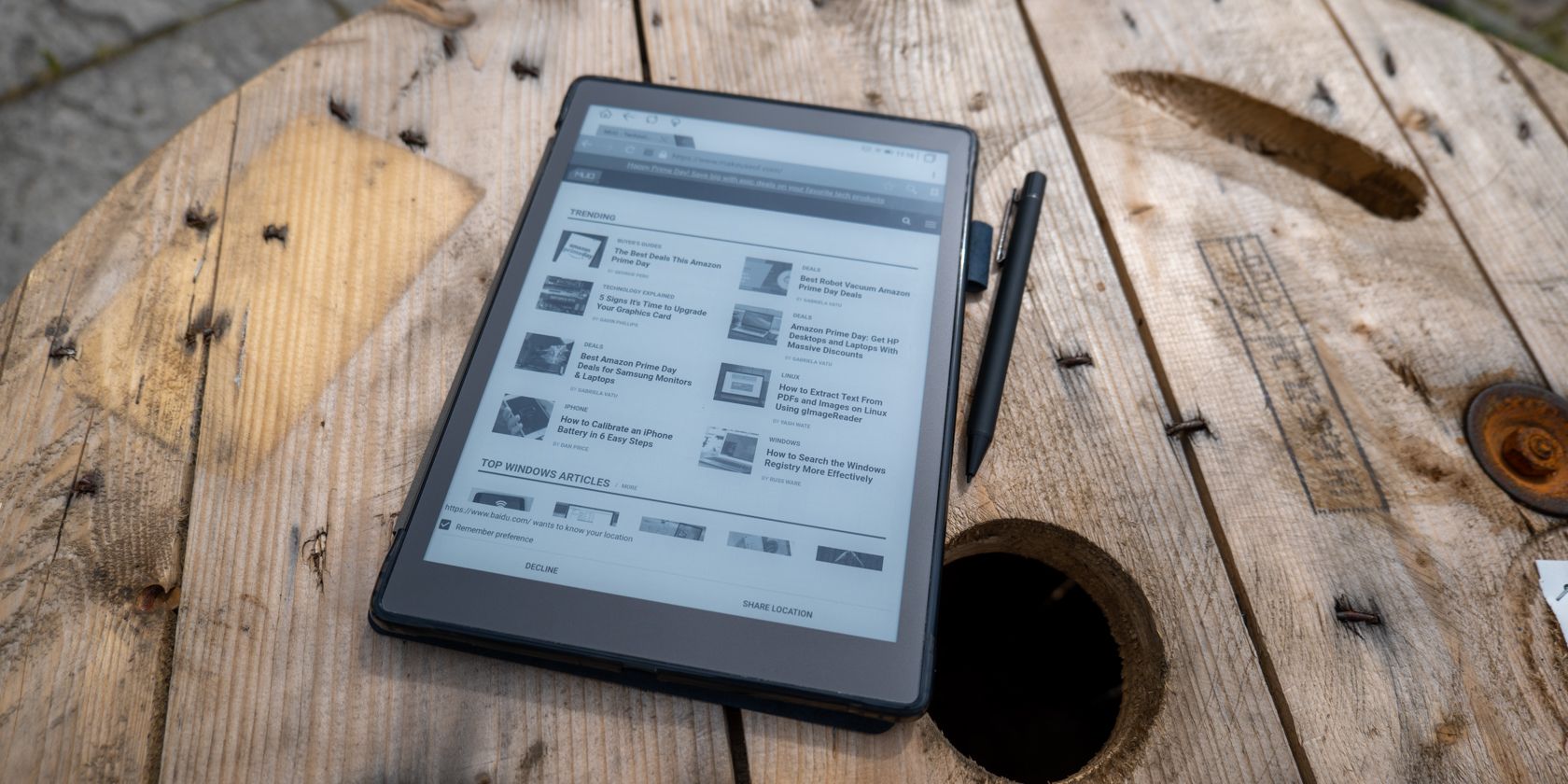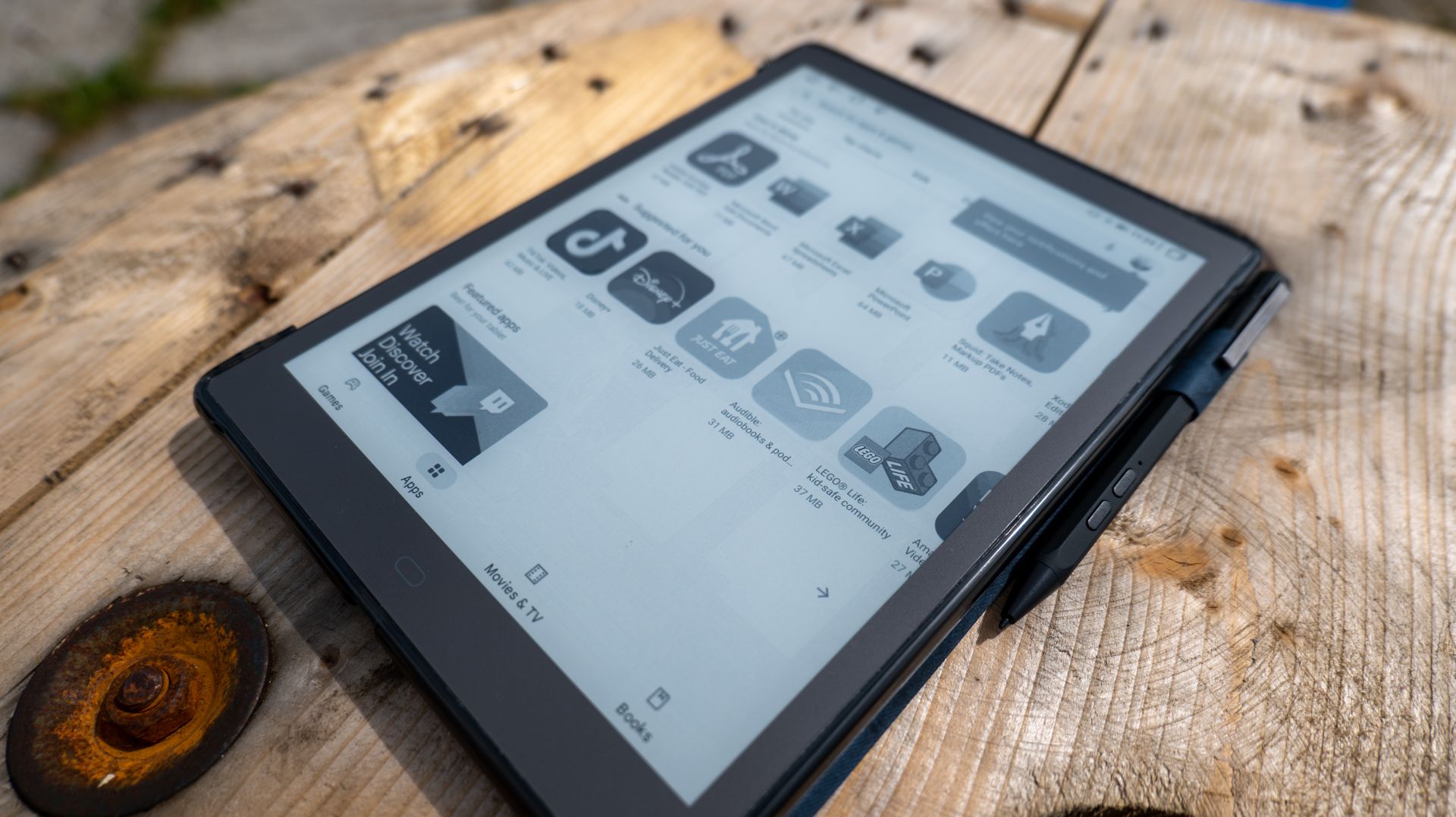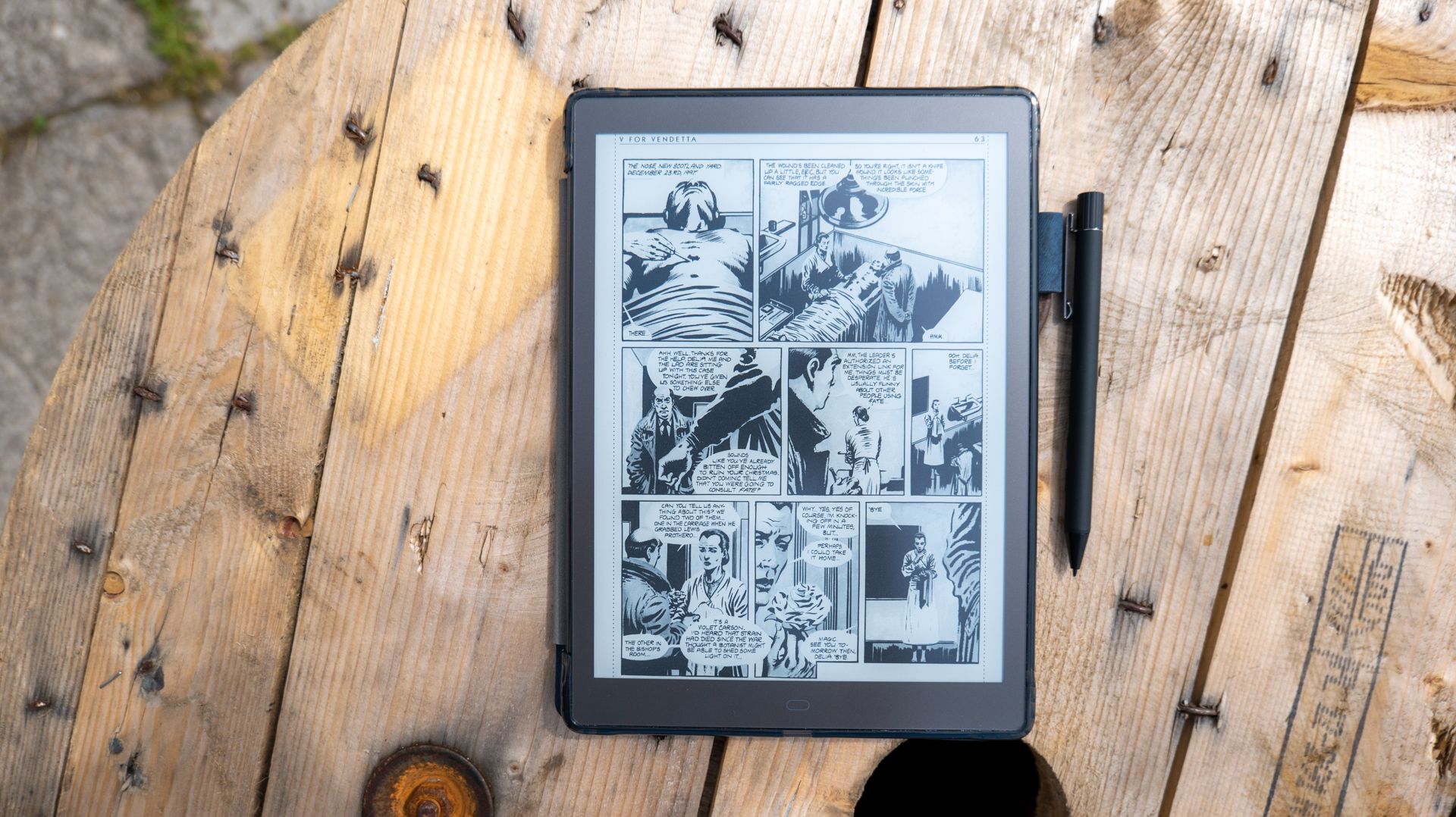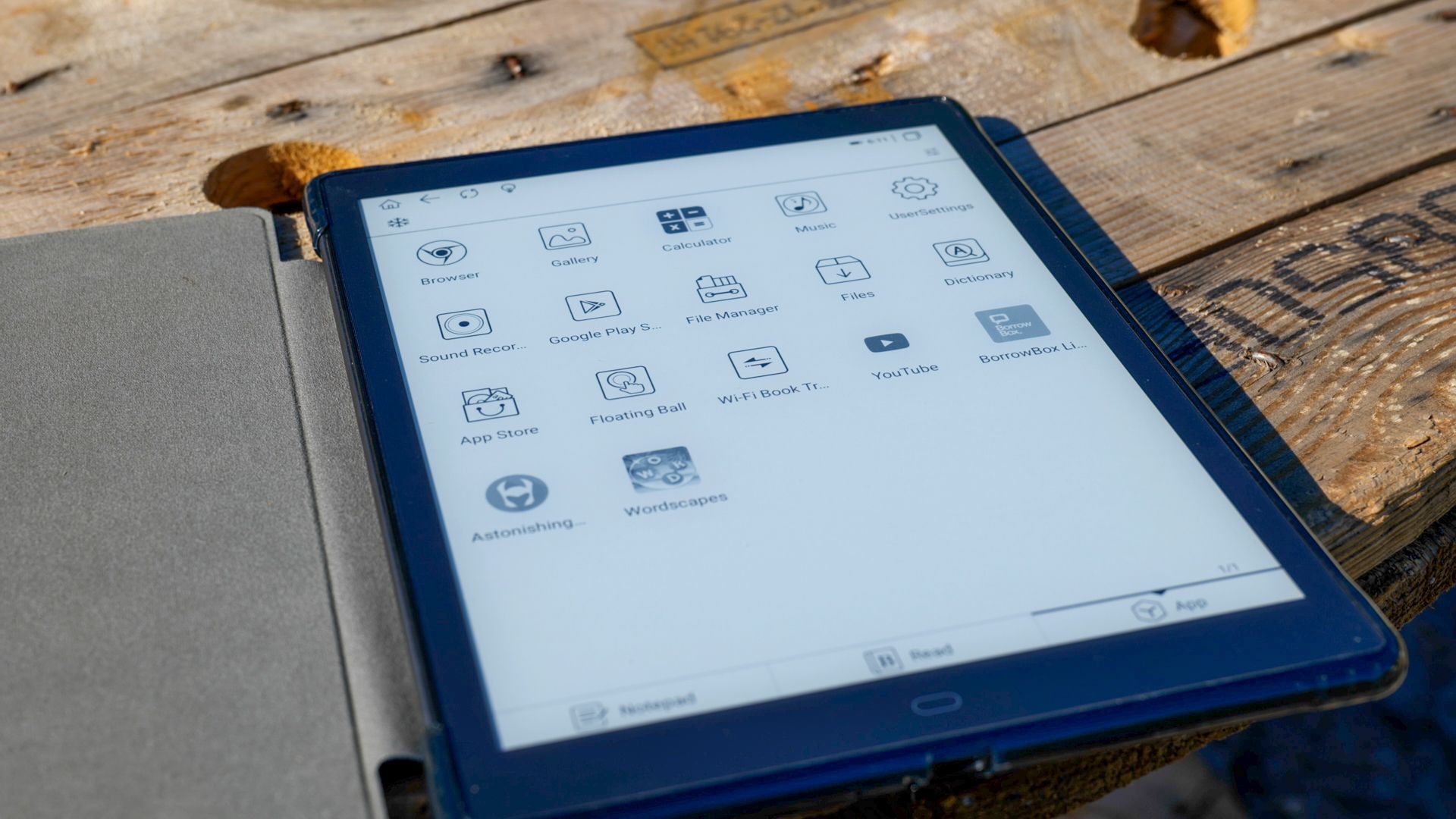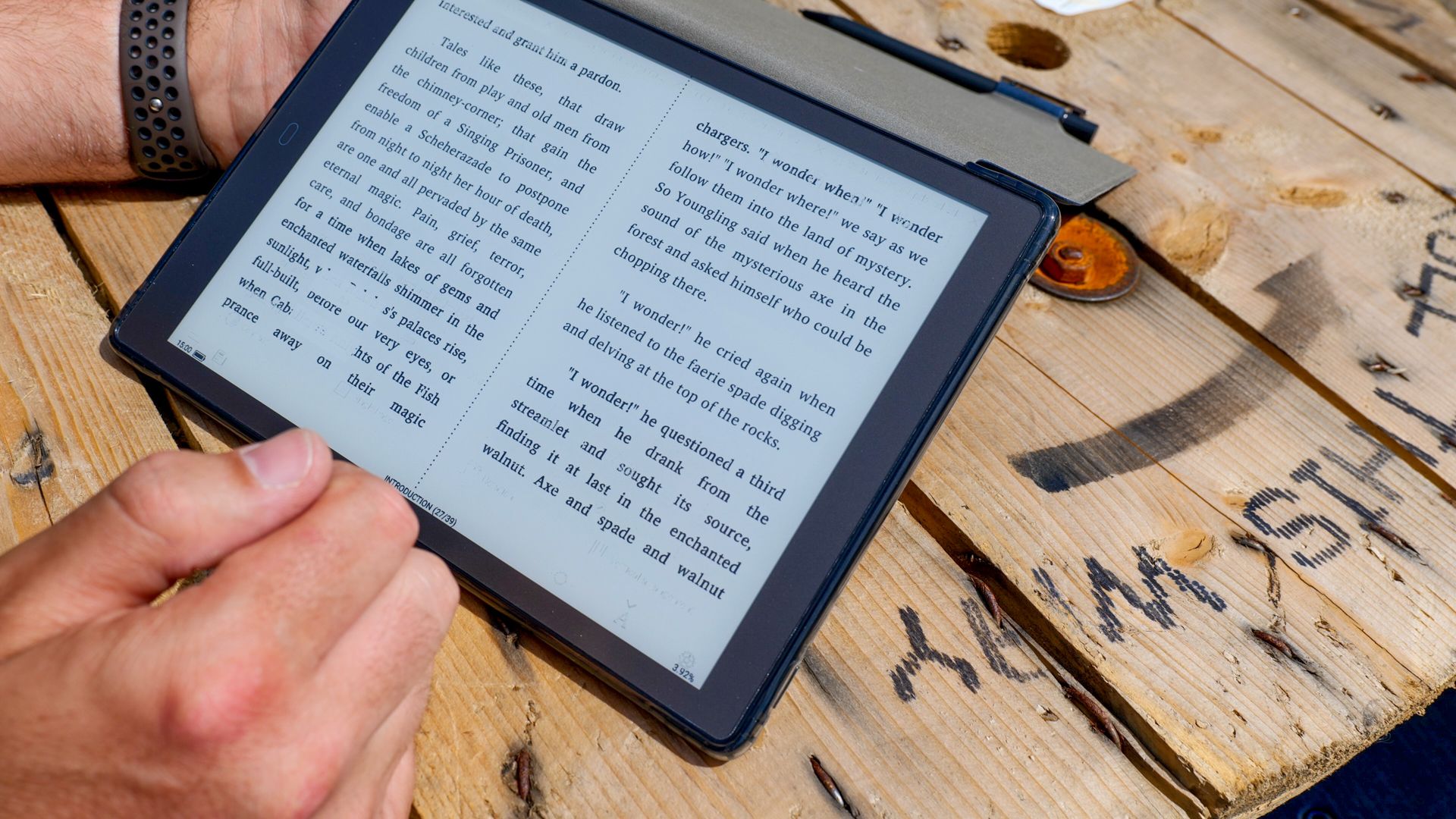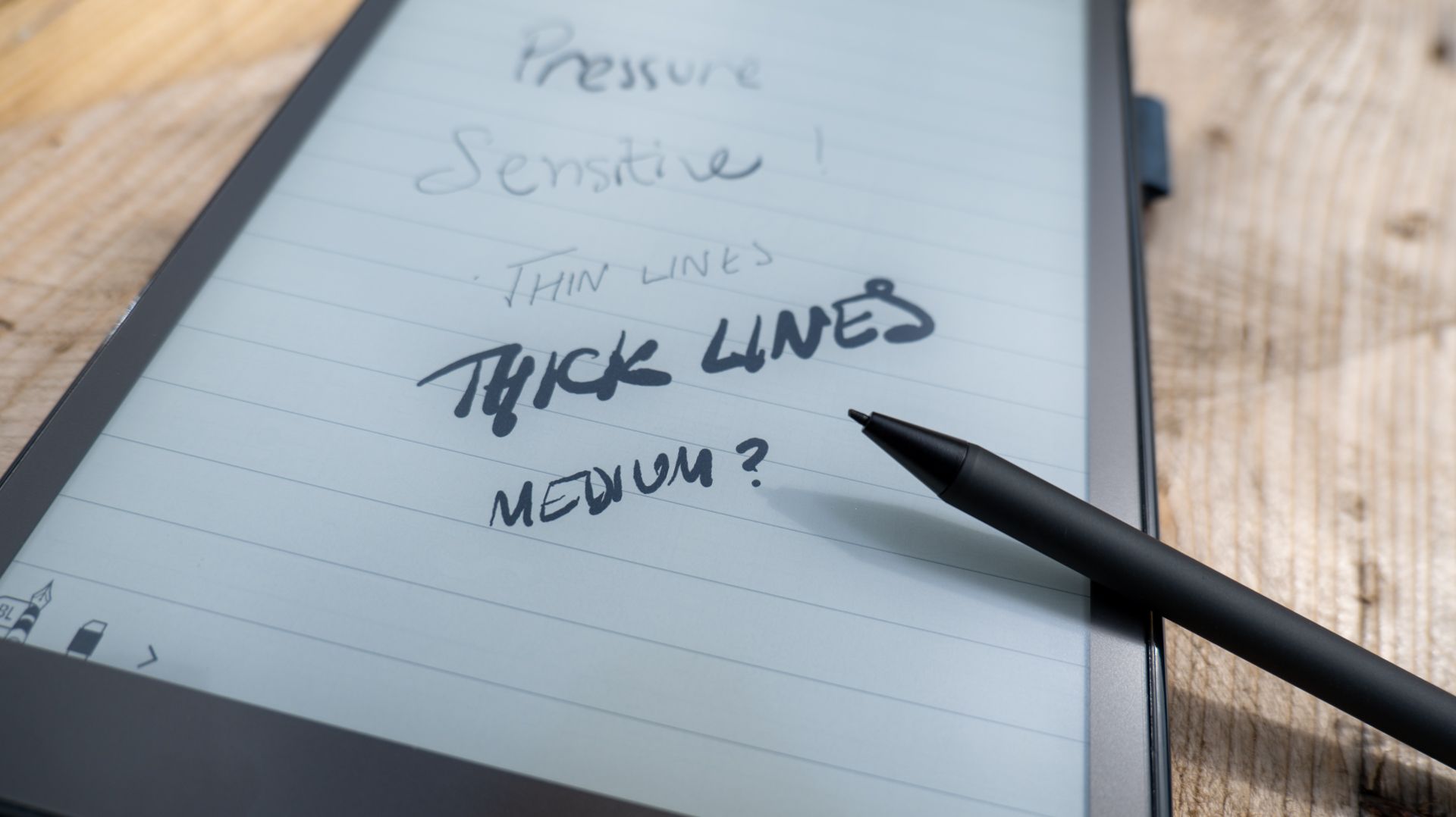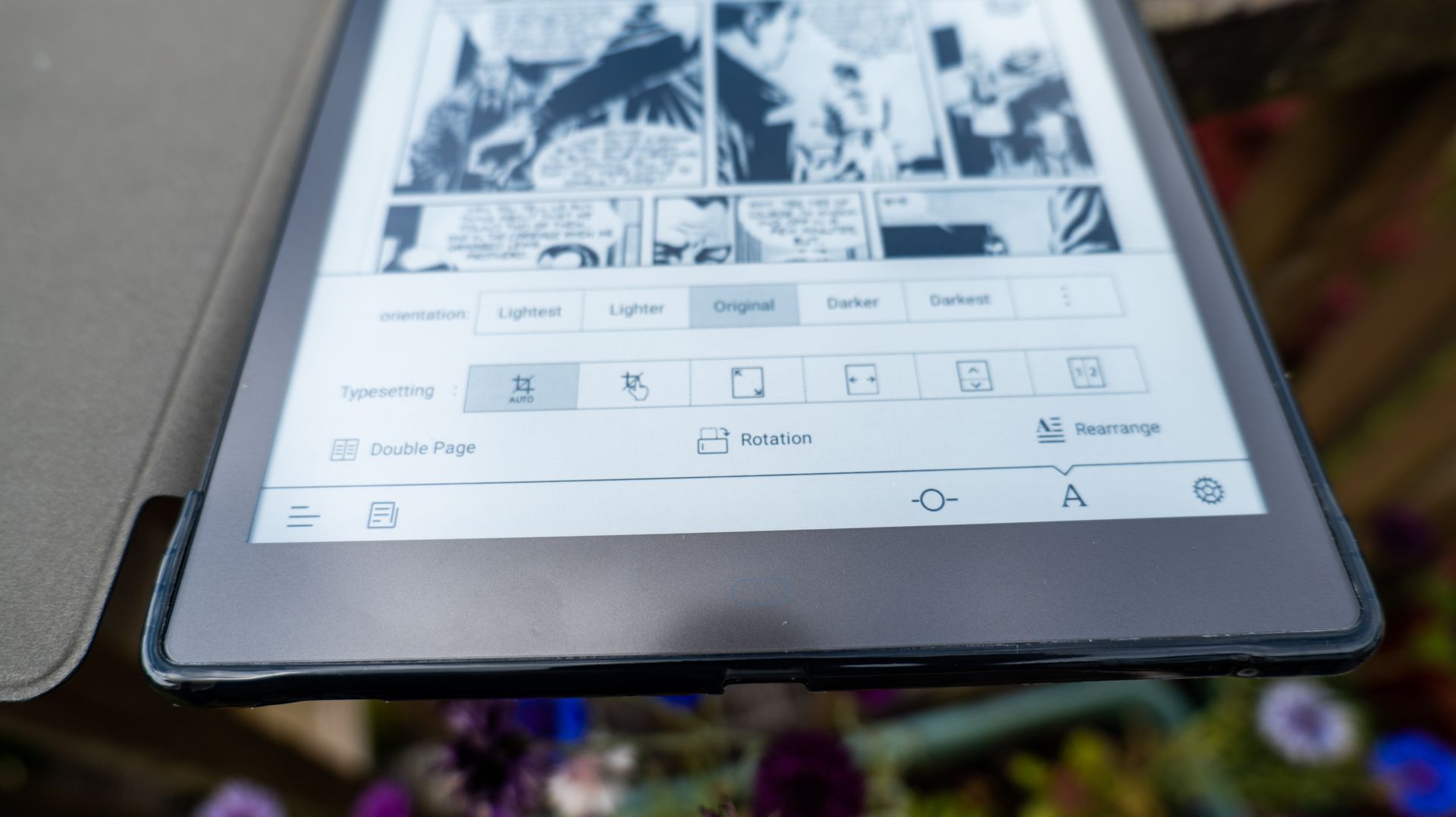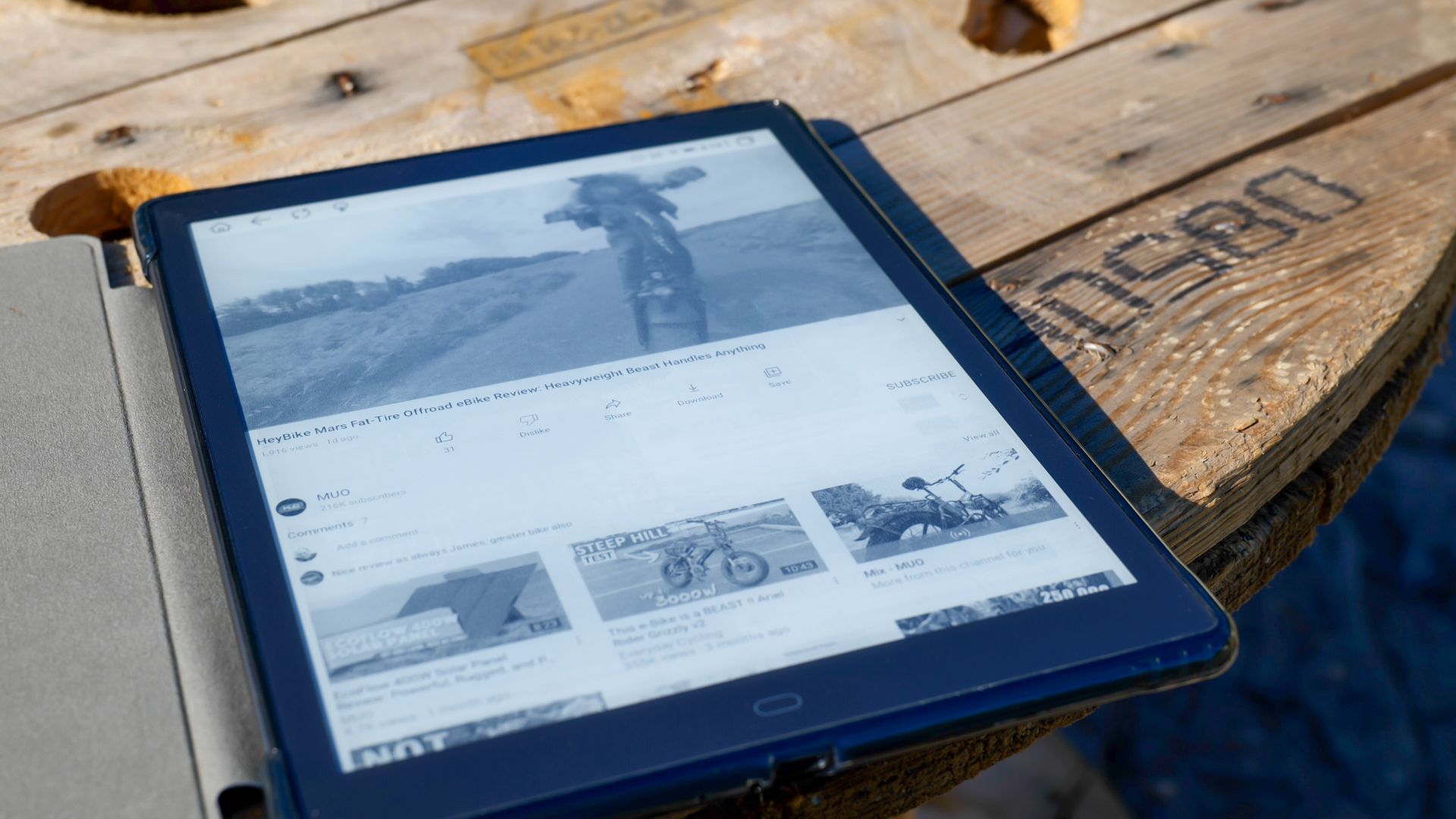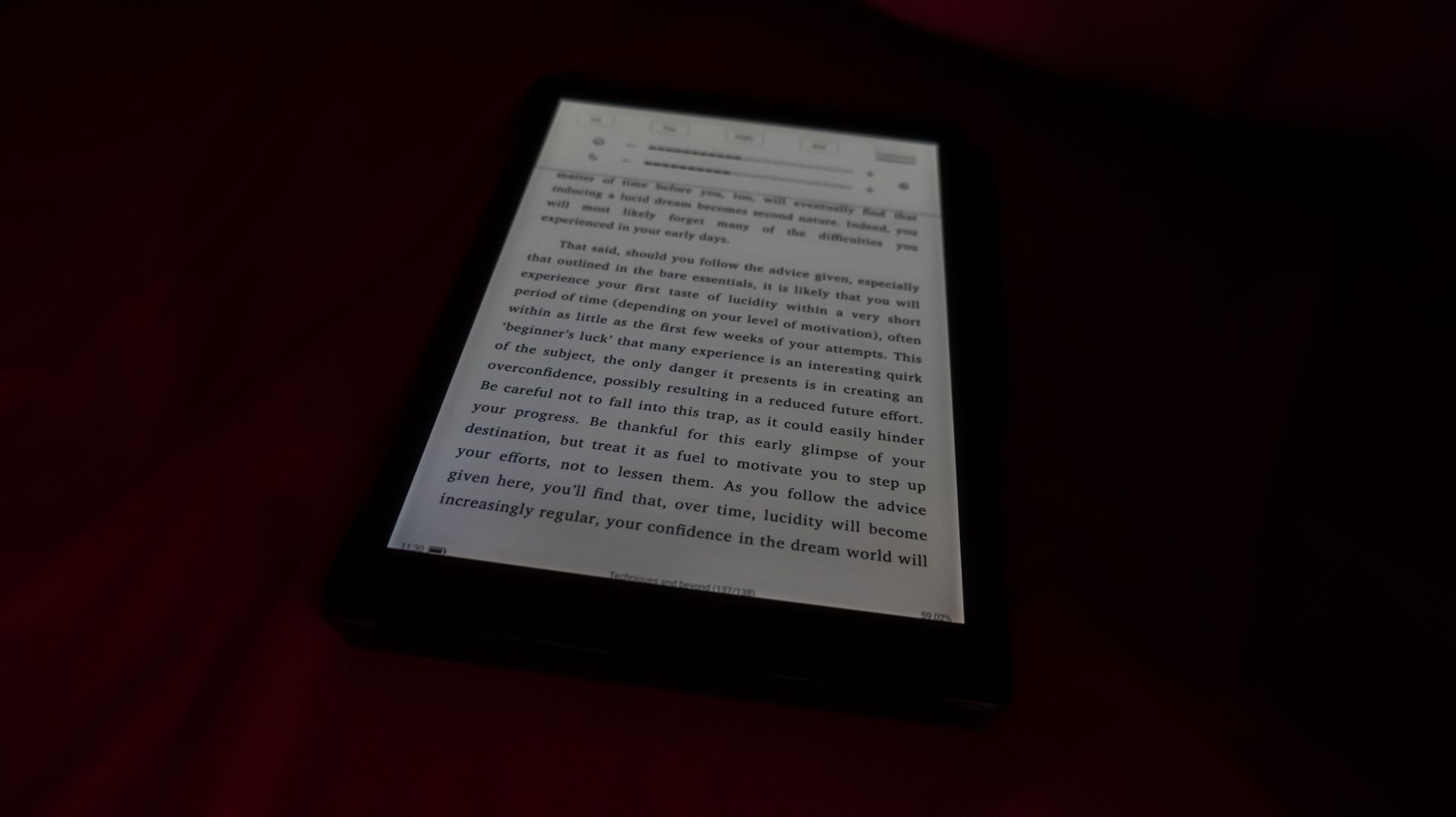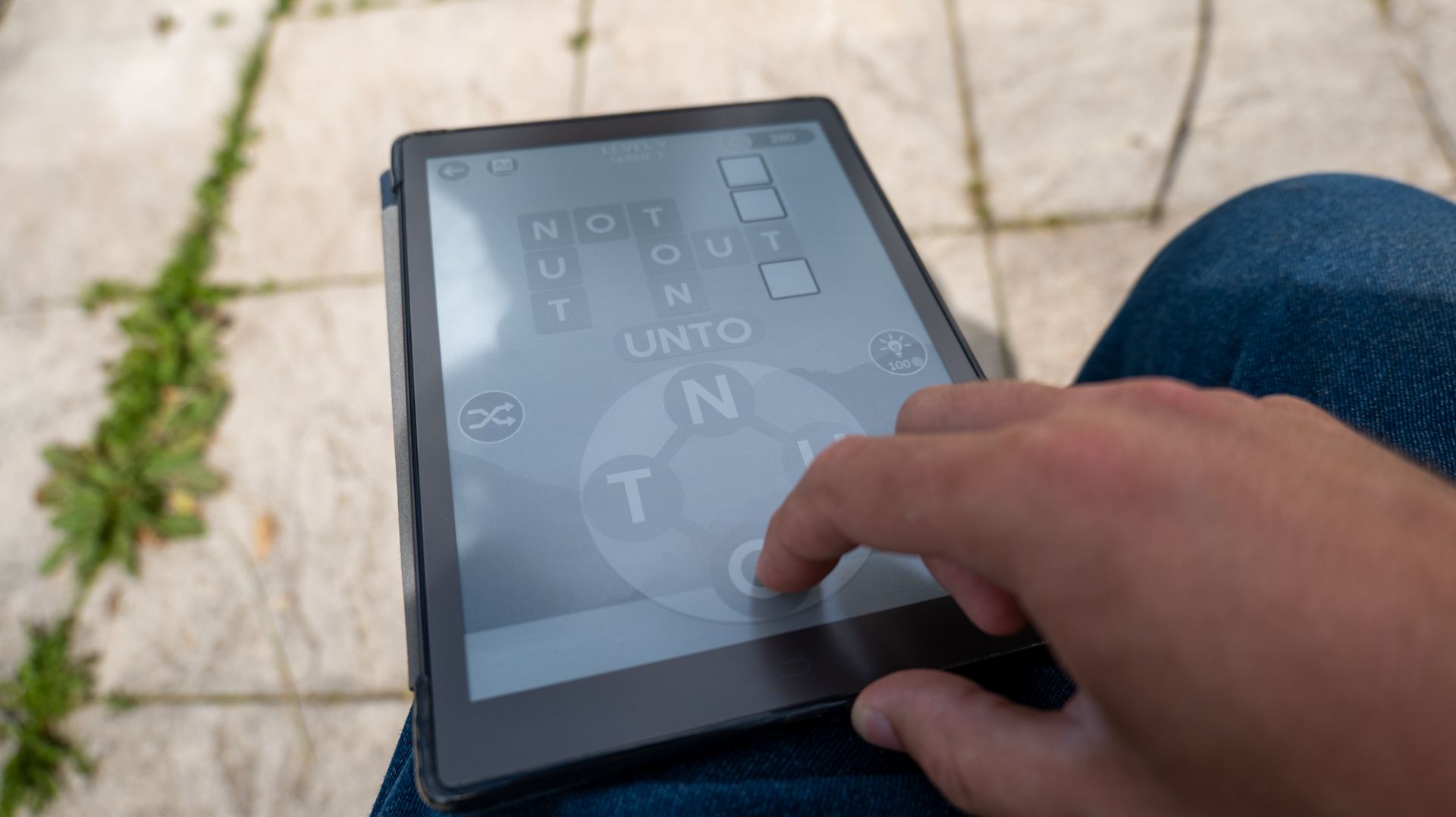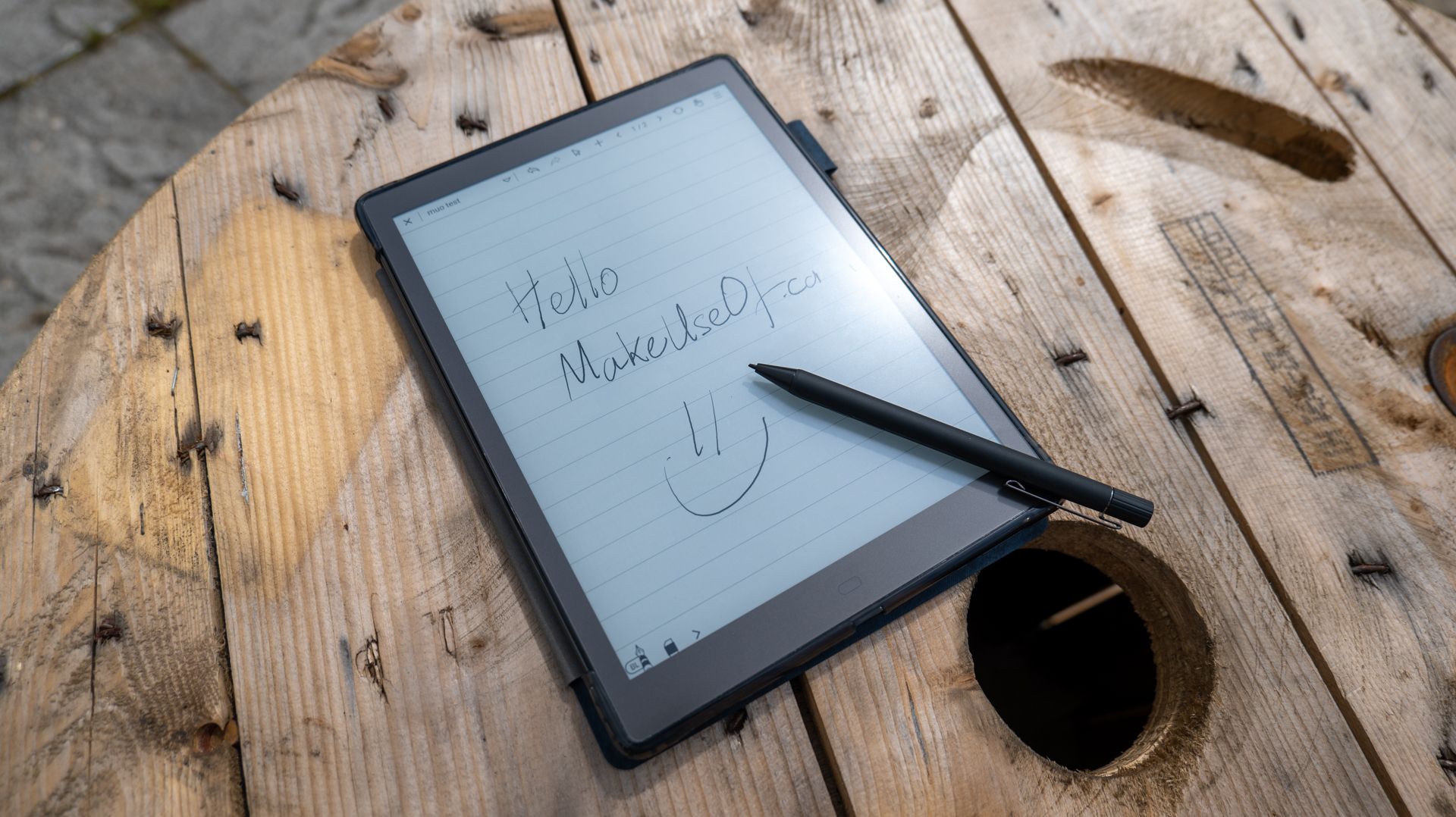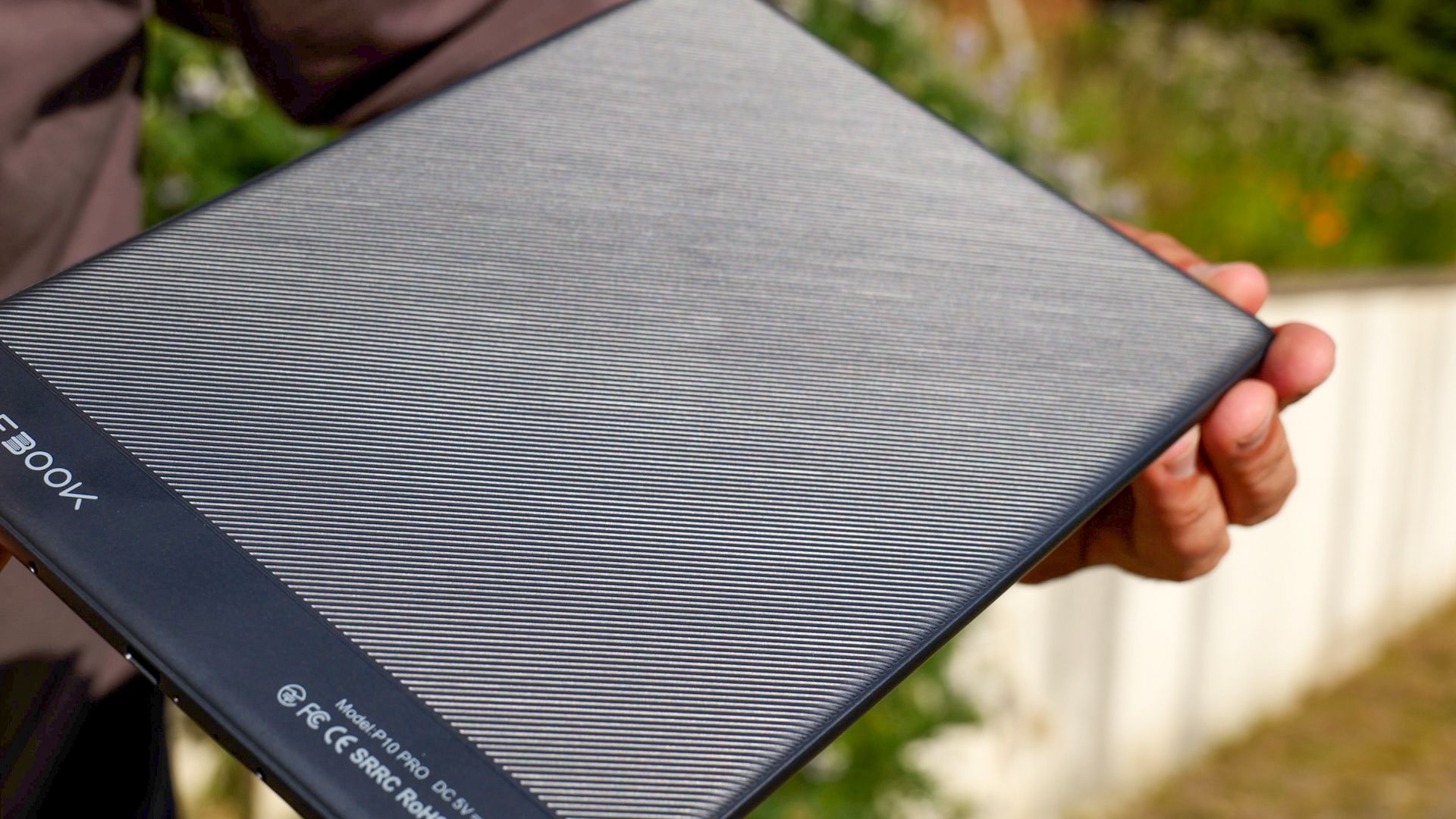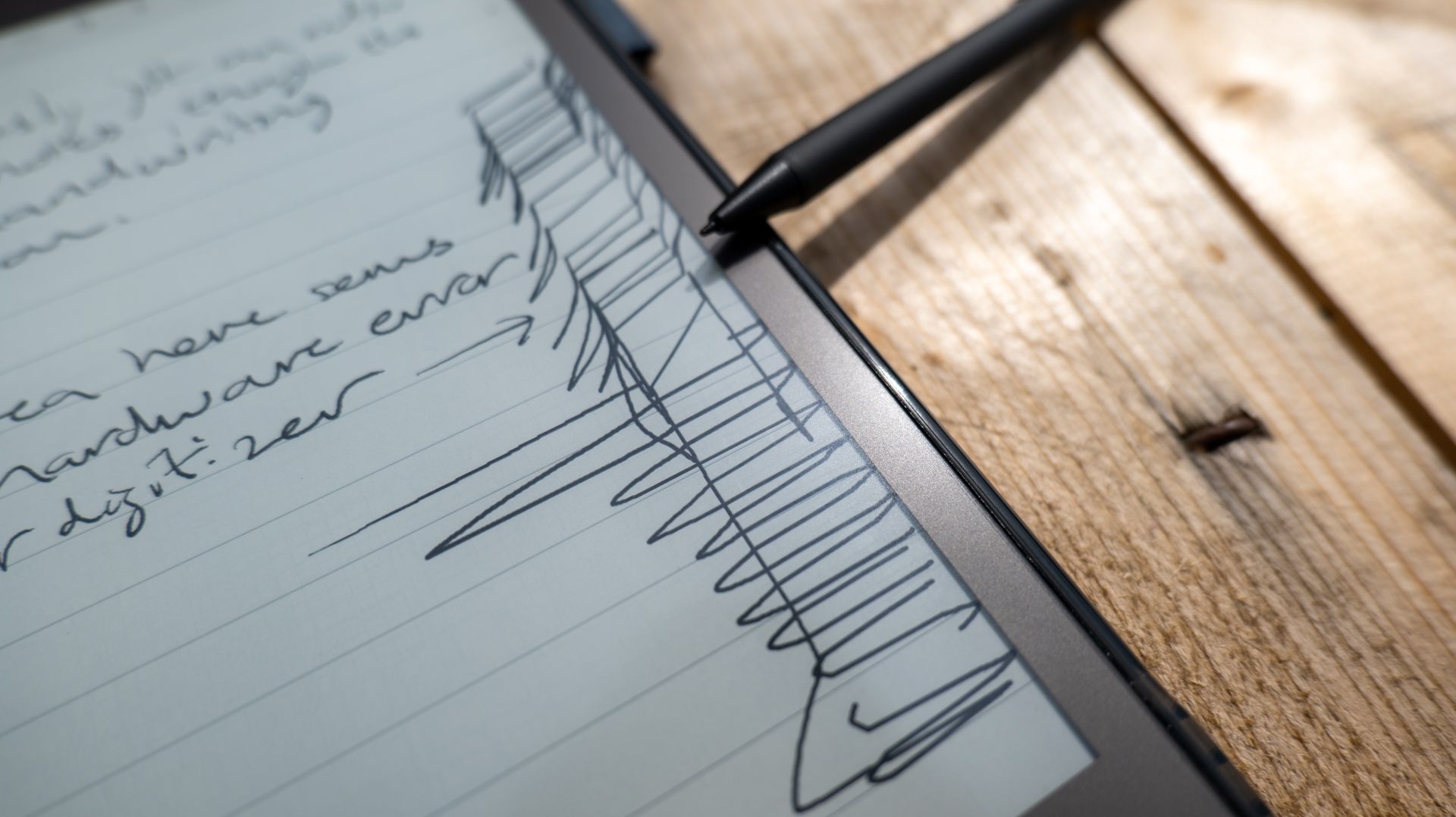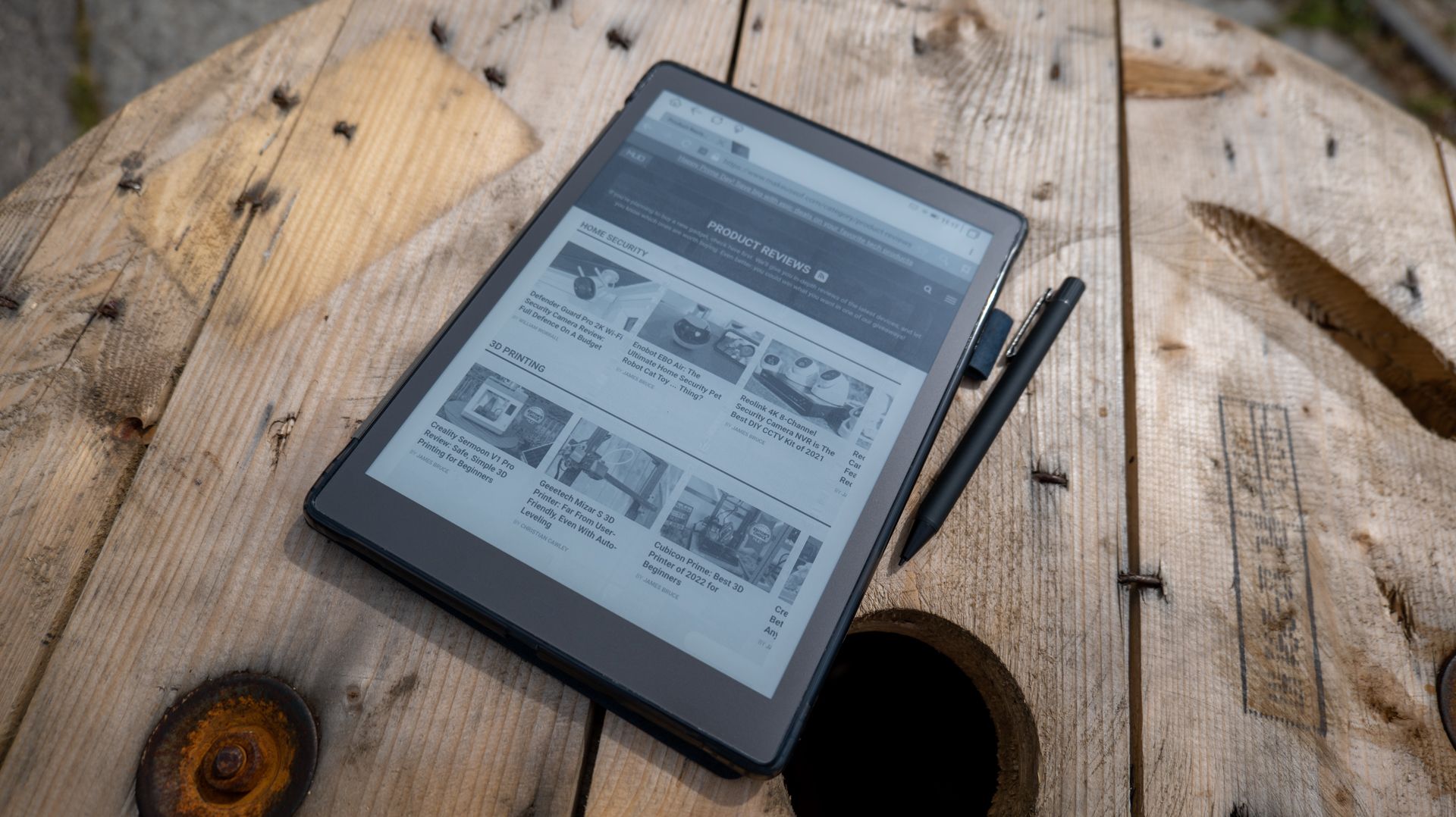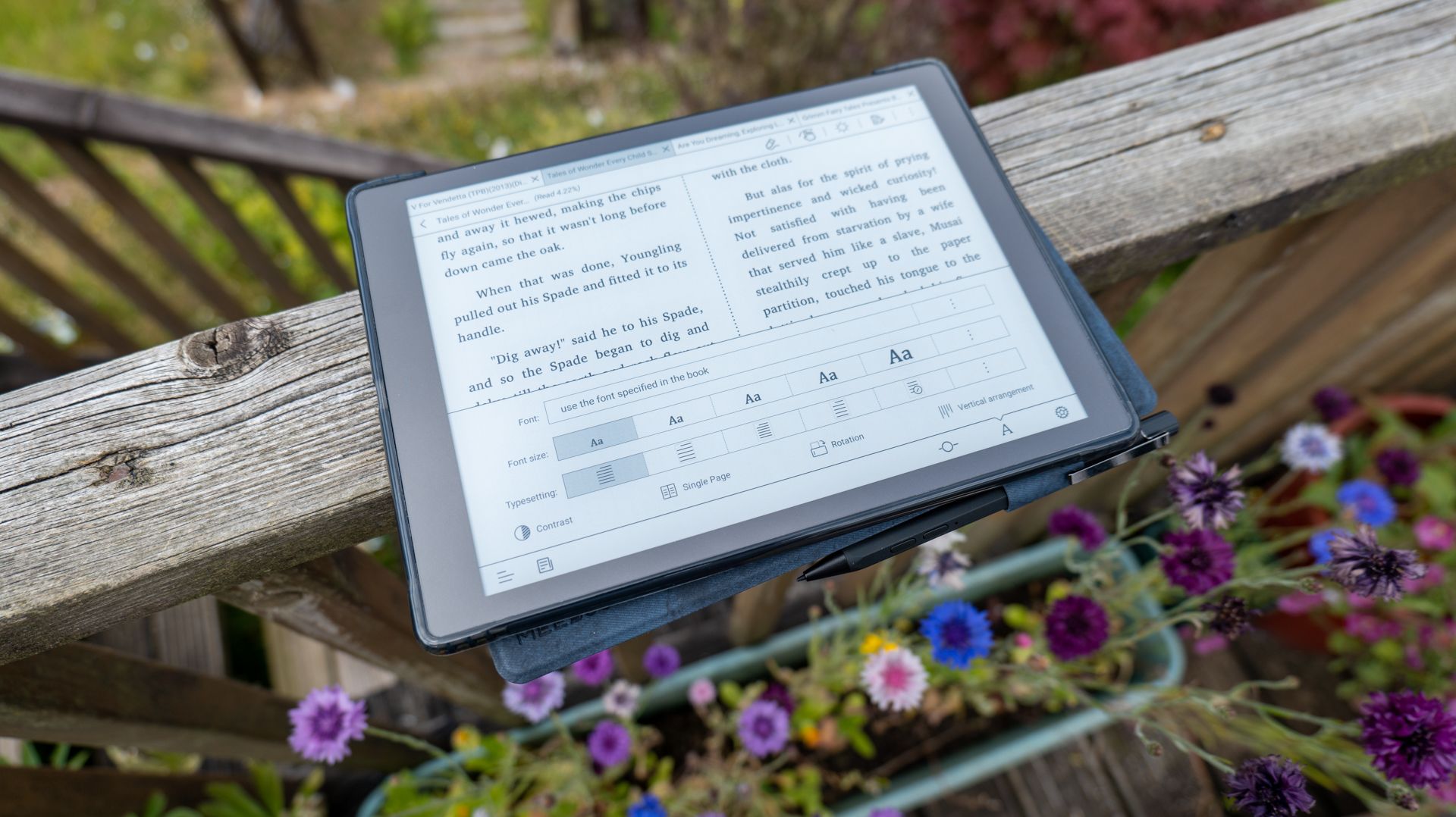Meebook P10 Pro
Ideal for those who want more freedom from their eReader. It has a good screen size, responsive notetaking capabilities, and compatibility with any eBook format you throw at it. The reading experience is superb with plenty of options to reflow text, customize layout, and read however you want to. It is a bit of a faff to get the Google Play Store working, but that's going to be true of any device with an e-Ink screen.
- Brand: Haoqingtech
- Screen: 10.1" Carta HD
- Resolution: 1200 x 1600
- Storage: 64GB
- Connectivity: Wi-Fi, Bluetooth, USB-C
- Front Light: Warm and cold, configurable
- OS: MeeOS, based on Android 11
- Battery: 3900mAh (a few weeks)
- Buttons: Power, home (capacitive)
- Weight: 458g (683g with case and stylus)
- Format Support: MOBI, ePub, PDF, CBZ, CBR, DjVu, and AZW3
- CPU: 1.8Ghz
- RAM: 3GB
- Reads any format eBook
- Easy to transfer files over USB-C
- Responsive page turns
- Good performance with PDFs
- 256-grayscale mode for better comic reading
- Casual games playable in high refresh mode
- Google Play takes some effort to get working
- UI can be awkward at times
The Meebook P10 Pro is a powerful 10.1" eBook reader with notetaking capabilities and the ability to run any Android app you want.
It's available now for $350 (or £247) pounds from techinthebasket.com, which includes an active stylus pen and gorgeous blue case. Is this the eBook reader and notetaking device you've been searching for? Possibly.
Why Would You Want an eReader Running Android?
When most people think of an eBook reader, they probably think of an Amazon Kindle. So why would you want a generic eReader running Android from a random Chinese company?
Primarily, to break free of the walled Amazon garden. With the Meebook P10 Pro, not only do you get the ability to install any Android app (even the Kindle app if you want!), it’s also super easy to get books onto here. There’s no DRM involved, so it's as simple as plugging in the USB cable to your computer and using the standard Android file transfer interface to drag and drop files or folders in. The standard built-in reader application handles any eBook file type you can think of, but if you have a preferred reader, you can use that instead.
If you’ve ever bought a book outside of the Kindle store (HundleBundle is great for this) and tried to get it onto your device, you'll know how much of a hassle it is. You need to email the book to your Kindle address, which inevitably means Amazon knows exactly what you just sent yourself. With Meebook P10 Pro you can read anything you like, in any format, and don’t need to worry about being surveilled or judged.
Specifications and Design
The Meebook P10 Pro features an e-Ink Carta HD 10.1-inch grayscale capacitive touchscreen display running at 1200 x 1600 pixels, which works out at 200 pixels-per-inch. This can be front-lit with both warm and cold LED lighting to your custom preference. It also boasts an active stylus digitizer layer with pressure sensitivity for digital notetaking.
Internally, you'll find a quad-core 1.8Ghz CPU, with 3GB RAM. It's plenty powerful enough to give a snappy UI performance and quickly turn pages.
For connectivity, you’ll find Bluetooth 5.0, as well as Wi-Fi. However, by default, the Wi-Fi is disabled after a certain time to save battery life. You should only enable it if you want to download a new app.
Power is provided by a 3900mAh battery, which may sound a little small for a tablet, but will last you at least a few weeks before needing to recharge under normal use. It also has a standby time of around five weeks. Of course, using Wi-Fi to browse the web, or playing games on it using high refresh mode is going to kill that much more quickly. While technically possible, it's not really designed for either. You can charge using a USB-C cable.
The only buttons on the device are for power (in the top right) and a capacitive home button (on the bottom of the front face). There is no microSD slot, nor are there volume buttons. The internal 64GB storage should be plenty.
Glass-fronted and with a metal surround, the Meebook P10 Pro weighs 458g (16oz), but you'll probably want the case and stylus on top of that, taking the weight to 643g (22oz). That's not exactly lightweight, but nor is it overly burdensome in your backpack.
The only point of note when it comes to the physical design of the P10 Pro is the plastic back, which is covered with diagonal ridges, giving an almost carbon fiber feel to it.
Regardless, you won't feel it once you slip it into the smokey black TPU of the case. The front is a gorgeous blue and black marble, while the inside cover is light grey felt. It feels nice, but seems like it'll pick up stains pretty easily. The included stylus sits securely on the edge. Of course, the case contains a magnetic switch, to automatically wake the P10 Pro when opened.
Reading Experience
Out of the box the included reader application built-in to the OS was compatible with any book format I threw at it, from PDFs to ePubs and Mobi. It also opens CBZ, CBR, and Djvu (dejavu) comic formats; as well as AZW3—though I can’t confirm the latter two as I don’t have samples of those to test with.
Page turning even within PDFs app is fast and responsive with little ghosting between pages. If your PDF has a large margin, you can manually set the page edges for better display or just use the automatic detection, which seemed to work well. You can even split double-page PDFs into single-page views, which is clever.
All the usual controls for text are present too, such as font sizes and text reflow, or automatic page turning. Though it doesn't detect orientation, you can manually switch to a double-page view if you'd rather use it landscape.
Reading in the dark is fine too, thanks to the customizable front-lighting system with both warm and cold LEDs. I noticed no hotspots.
A basic Google text-to-speech engine is included which doesn't require Wi-Fi, but it's quite robotic.
The reading experience on the Meebook P10 Pro is superb, as you’d expect from a company that’s been making e-readers for years now.
Android 11 and Google Play Store
The underlying MeeOS is based on Android 11, but obviously it's heavily customised for use with an e-Ink screen, which isn't officially supported by Android. You have a choice of either the standard homescreen, which has separate tabs at the bottom for books, notes, and other apps; or you can go for a more traditional tiled layout for everything.
While Google Play comes installed, you'll need some additional steps to make it work, and it remains technically unsupported by Google. That means you'll need to whitelist your device ID for use with your account and accept that you won't benefit from Play Protect security features.
MeeOS makes the whitelisting process itself quite easy. Upon launching Google Play, you'll be shown a dialog and invited to the page from which you can whitelist your device ID. You don't even need to figure out what the ID is, as it's already filled out for you. Just tick the box to say you're not a bot, then submit. The dialog box warns it might take a few hours for Google to accept the submitted ID, but when I reached out to support I was told it might even be a few days.
Unfortunately, even after whitelisting my device, it still wouldn't let me use Google Play. I eventually figured out that I also had to go into User Settings > Apps > Google Play Store, and delete the storage cache; then repeat the process for Play Services. After restarting again, it worked. In fairness, this isn't the fault of Meebook, so I've not written this to criticize the device. It's an annoying step for any unsupported device, and I'm putting it here in case you have the same problem.
That said, even if the device can run any Android app, that doesn't mean you should. I was surprised to find casual word games were quite playable with A2 high refresh mode enabled. But, the experience is still going to be substandard compared to an actual smartphone, which you're probably carrying anyway.
If you have a favorite e-reader or comic app you'd rather use, or if your local library supports BorrowBox or Libby, those should run fine. You have a lot of freedom to run anything—but with great freedom comes great responsibility (or something like that).
A2 Refresh and 256 Grayscale Mode
e-Ink screens are great for daylight visibility and low power usage (they only need electrical power to redraw the screen contents), but they're also quite awkward to work with outside of specially designed apps. To facilitate Android apps that have animations and require a snappier user interface, the Meebook P10 Pro will automatically switch into a high-refresh mode called A2, though you can manually disable or enable it at any time.
In this mode, the screen quality degrades somewhat, with less overall contrast and resolution, but allows the screen to update much more quickly than normal. We're not talking 60FPS here, of course, so you won't be playing any racing games on it, but it does make YouTube videos almost bearable to watch.
New to the P10 Pro is also a 256-greyscale mode. This is a subtle tweak that makes reading graphic novels better by smoothing out gradients. For instance, here's a panel containing a sky without the 256-mode enabled:
And this is the same panel with it turned on:
As I said, it's a subtle difference. And of course, the screen is still black and white, so if you prefer your comics with a dash of color as intended, you might still be better off with a tablet.
Notetaking
One standout feature of the Meebook P10 Pro is the highly responsive WACOM digitizer layer, which works with an active stylus. The digitizer is pressure sensitive and has only minimal latency. I found writing on the P10 Pro felt quite natural.
Since it's an active stylus, you don't need to worry about your hands or fingers accidentally making big splodges on the page. However, I did find myself accidentally triggering the page turn gestures. If this turns out to be too annoying, you can completely disable gestures.
By default, notes take up their own tab from the homepage. Each page can be given its own template, such as ruled, graph paper, or a to-do list.
Unfortunately, there doesn't appear to be any text recognition. This isn't a huge problem for me as it's mostly sketches I use the stylus for, and my chicken scratches are barely human-readable let alone by a machine. If I wanted text, I would type faster than I can write. But if this is a feature you want, look elsewhere.
Our test model also appeared to have slight hardware defect, with a thin strip of the right-hand side digitizer layer unresponsive, so you might want to check this first thing upon receiving yours.
Overall though, I was really impressed with the notetaking capabilities. It far exceeded what I expected from an eReader.
Boyue Likebook or Haoqingtech Meebook?
You're probably going to see this model being advertised as both the Boyue Likebook P10 Pro or the Haoqingtech Meebook P10 Pro. They're the same thing, from the same company. Strictly speaking, Boyue was dissolved after financial difficulties; but like a phoenix, Haoqingtech and the Meebook brand arose from the ashes. They also took over the Facebook page. Since it's the same staff and the same code, you'll notice a lot of similarities between previous Likebook P78 or P10 models, and the new Meebook devices.
Is the Meebook P10 Pro for You?
If you already have a Likebook P10, you don't need to upgrade. It’s a bump from 2GB of RAM to 3GB, and from Android 8.1 to 11, as well as a better stylus. Unless you have an app that’s specifically incompatible with Android 8.1, it's not enough of a specs bump to justify upgrading. eReaders last longer than regular tablets due to less strain being placed on battery. The more times you charge, the faster the battery will degrade.
As your first eReader and notetaking device, I can definitely recommend the Meebook P10 Pro. It has a good screen size, responsive stylus, and compatibility with any eBook format you throw at it. It is a bit of a faff to get the Google Play Store working, but that's going to be true of any device with an e-Ink screen.
Even if you don't want to install other apps, the core experience is worth it. You won’t be limited in what you can read, and needn't worry about converting formats, or having to email yourself just to access a book you own...
On the downside, it is still Android under the hood, so it's not as user-friendly as, say, a Kindle would be. If you want a more curated, personalized experience, perhaps focussed solely on reading without any notetaking capabilities, and don't want to deal with Android quirks—this isn't for you, and that's ok. Sometimes less choice is better.
On the other extreme, if you only want a digital notetaking device with eBooks secondary, you might prefer the Remarkable 2. It has a better writing experience with less latency, and a slightly larger screen area to write on. It's also more expensive.
The Meebook P10 Pro is a good all-rounder. It offers a great reading experience, compatible with a wide range of eBook formats, also does digital notetaking, and gives you the freedom to install any Android app—all for a very reasonable $350.

